Teaching writing in ten steps you say? Why yes there is a method to the madness on how to teach young writers!
- Do not be afraid to let kids spell phonetically!:
Often referred to as “inventive spelling”, young writers often benefit from STARTING OUT to write with the sounds they hear. Sometimes we might think that if they spell words incorrectly to begin with, that affirms poor spelling. The KEY is in requiring correct spelling as young writers learn new spelling rules (as in long vowel patterns with a silent –e at the end or medial vowel pairs). Just because we begin with inventive spelling, does not mean your child has to stay there. Close monitoring and reinforcement of new spelling rules that you introduce (either with your reading or spelling programs) should be reinforced in your writing routine as well. Please note: Learning to spell high frequency words correctly (the, this, it, is, there, their, my, etc…) is the exception to this approach. - Have a plan!:
It is never too early to get kids planning their writing. I have seen several approaches to teaching planning a paragraph by working backwards (reading a passage, taking main points and re-writing in your own words from said passage). I have never tried this approach, but I do believe that writing success comes from ownership and starting YOUNG (end of kindergarten and first grade for a simple paragraph). If children own their writing, they often tend to enjoy writing and become successful writers in a short period of time. Young writers benefit from a visual based plan such as a web. Although other graphic organizers can be used, webs have proven to be the quickest and most utilized for my own children and past students. Where to start? With the youngest of writers it’s a good idea to have them be the leader (ask them about something that interests them). Reports or factual writing are often easier to produce, at first. So an example would be “Taking care of a pet”; “At the zoo”; “Ice Cream” etc… If you are not sure how to begin, please use the pictures below to assist you. Encourage your child to give different facts or statements about the main idea (which is written in the center of the web). As they give you a comment or fact, guide them in writing the main idea of that statement (in one or two words) as their FIRST IDEA. Continue until 4 or 5 total ideas are completed. Then as you begin the writing part, they can use their web to form their sentences using each idea as one sentence.
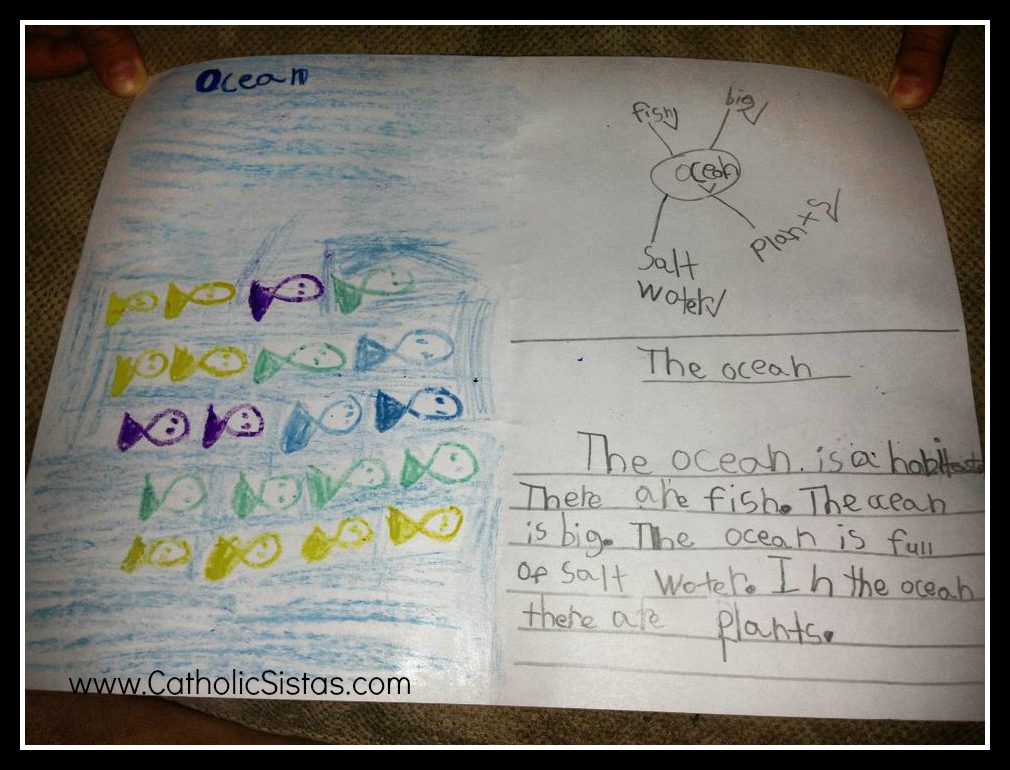
- It is never too early for STRUCTURE!:
Do not think your child is too young for structure. Teach them early how to write a title (with Capital letters where appropriate), how to indent before beginning the paragraph, and how to complete each idea (sentence) with a period and then check off the idea from the web (they can’t check off the idea, until the sentence is complete and has a punctuation or in kid friendly terms an ending mark). Along with that structure, make sure you use correct vocabulary to identify what you want them to do (indent, topic sentence, detail). - Give yourself and the children time.:
This will not happen overnight. There are lots of “growing pains” in teaching your child how to write independently. Start small and don’t think you are hindering them by guiding them (A LOT) in the beginning. There are those days when we have to re-read their sentences to them and say “Okay, what goes next?” or “Are you sure that sentence is finished?” It might seem like lots of work and some days it might seem like too much trouble from what you’re getting out of it. Give it some time… it will get better and soon enough you will have an independent writer to which you can give a passage and say “Okay, now write a summary of what you read”. - Practice makes perfect!:
As with all activities, we progress and become successful when we practice often. We can’t expect a child to get better at writing if they aren’t doing it often. For young writers, writing a paragraph or two a week MINIMUM is going to help them. Remember, at first you will need to guide them tremendously (even to the point where it seems like you’re doing most of the work- without holding the pencil yourself). To be honest, it might be a good idea to model a simple paragraph to your child explaining step by step what it is you are doing or “thinking aloud” to show the procedure of thinking it through and getting it down on paper. Scaffolding is the best way to approach writing instruction (you let go of the reins little by little). - Start small and build up.:
What if your child is not ready for a paragraph? For some children, writing will be a huge struggle. If you start from Kindergarten with clear expectations, that attitude will often dissipate. In Kindergarten, some of the most important skills for a child when it comes to writing is becoming familiar with sight words and using them appropriately; sounding out simple cvc (consonant-vowel-consonant) words like cat, dog, pig, etc…; learning that letter formation is important (some letters are tall letters, some are short, and some go “under water”); all sentences begin with a capital letter and end with a punctuation mark (ending mark); and some words and special names have a capital letter too like the word I (and their own name too). To help your child with sentence structure, a simple and effective strategy is color-coding writing pages to help them gauge where tall letters begin, where short letters begin and what “under water” means. Use predictable writing to help get off on a good start. Predictable writing will allow your child to refer to the first sentence he or she wrote and become fluent spellers for high frequency words (try to concentrate on only 1 or 2 new high frequency words at a time). They can use a Popsicle stick to separate words (although their pointer finger works just as well). The following idea was found on Pinterest (and there are tons more for tracking and letter formation):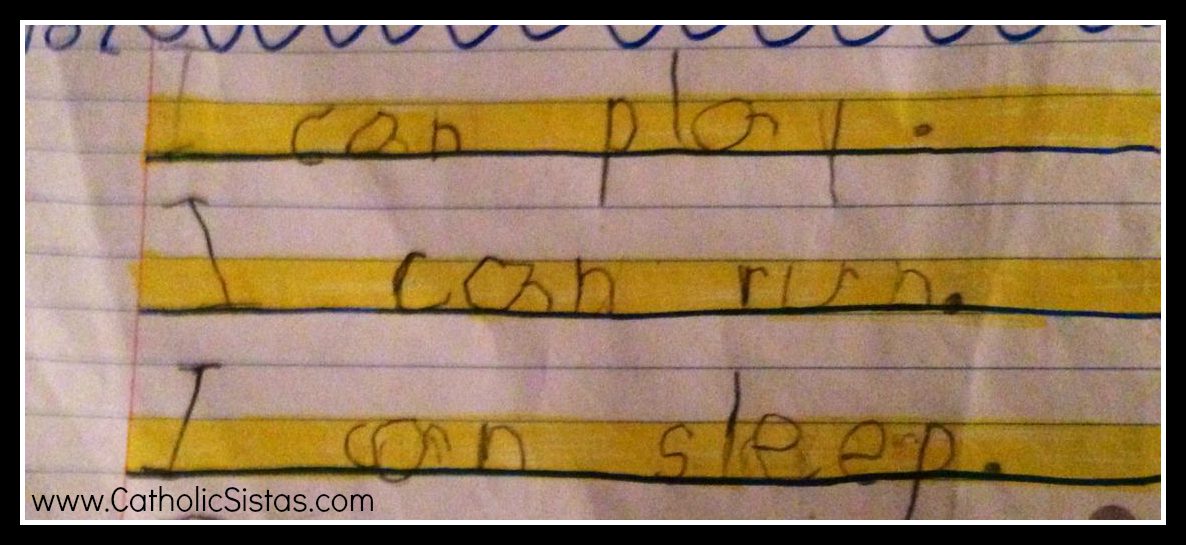
- Use writing for struggling readers:
In many cases writing can help struggling readers. If your child struggles in reading, you can turn to writing to help with fluency. Writing predictable sentences will promote fluency as well as the use of rhyming words. Some writing activities to build word families can help your child with writing AND reading. Building all the words in any given word family (-at, -op, -ug, -et, etc…) can help kids learn to decode quickly and remember how to spell them in their writing compositions. - Keep expectations reasonable.:
At what age should my child be able to INDEPENDENTLY write a sentence? Plan a paragraph? Plan and write a paragraph? Spell correctly? These are all good and appropriate questions, some that homeschooling parents second-guess themselves about. Remember starting early and building from there will get kids going and all that matters after that is progress, progress, progress. There may be
some children that are ready to write 5 paragraph essays in 3rd grade or maybe not until 6th grade. The KEY is getting started as early as you can. Here are SOME general guidelines of what I personally expect from my kids (granted they still work on perfecting them in older grades). Here’s a good set of goals:- INDEPENDENT SENTENCE (Kindergarten)
- GUIDED PLANNING AND PARAGRAPH WRITING (End of Kindergarten/First Grade)
- INDEPENDENT PLANNING AND PARAGRAPH WRITING with predictable sentences (First Grade)
- INDEPENDENT PLANNING AND PARAGRAPH WRITING with varying ideas and sentence structure (Second & Third Grade).
- MULTIPLE PARAGRAPH WRITING w/PLANNING (Late Second grade/Third Grade) From 3rd grade on, it is about perfecting paragraphs and making them more sophisticated (larger vocabulary and eloquence)
- ESSAY WRITING w/planning (Varies in age and maturity- recommended start with guidance in 4th/5th grade)
- Assign Topics to get the mind going.:
You might be thinking, “well when do I start assigning topics”? I’d start as soon as your child has become comfortable writing semi-independently (that is planning and writing a paragraph using the plan). This may vary from child to child (even within the same family). Sometimes writing can become unbearable if you assign a topic too often. The goal is getting your child to say “Can I write a paragraph about _______?” For some kids, that just will not happen. Every child is different. Writing may never be enjoyable, but it’s a necessary skill for your child. So, if we can at least make writing somewhat comfortable and familiar for them from an early age, they will be successful even if it is not their favorite subjects. If you have a child who DETESTS writing, perhaps giving them more reign of the topics might be more suitable (but hold them to it and ensure they plan and write to their ability). - Incorporate the Faith to writing:
For many homeschooling families, the faith is the basis for their whole curriculum. Some families might have a specific Religious Curriculum they prefer and some create their own. In any case, if you have a weekly theme for your religious instruction, you can incorporate the writing instruction into your religion lessons. In our family, we use the Faith and Life series (which I love). The program works with one chapter a week. Each week, our children read their chapter and we discuss it and attribute or connect it to similar stories in the Bible or the teachings of the Church. Our children then are required to write a paragraph summarizing the chapter (for the older children, they may have to choose a specific theme within the chapter to write about). Connecting writing with our rich Catholic Faith can make it more substantial and understandable to our children when they write about it. It strengthens the faith and often the concepts and teaching take root. When this becomes routine, they eventually do not ask for help; they read and write (which is helpful when you have multiple children to homeschool) and from their writing you can really determine if they “get it”.
Here are some samples from my children:
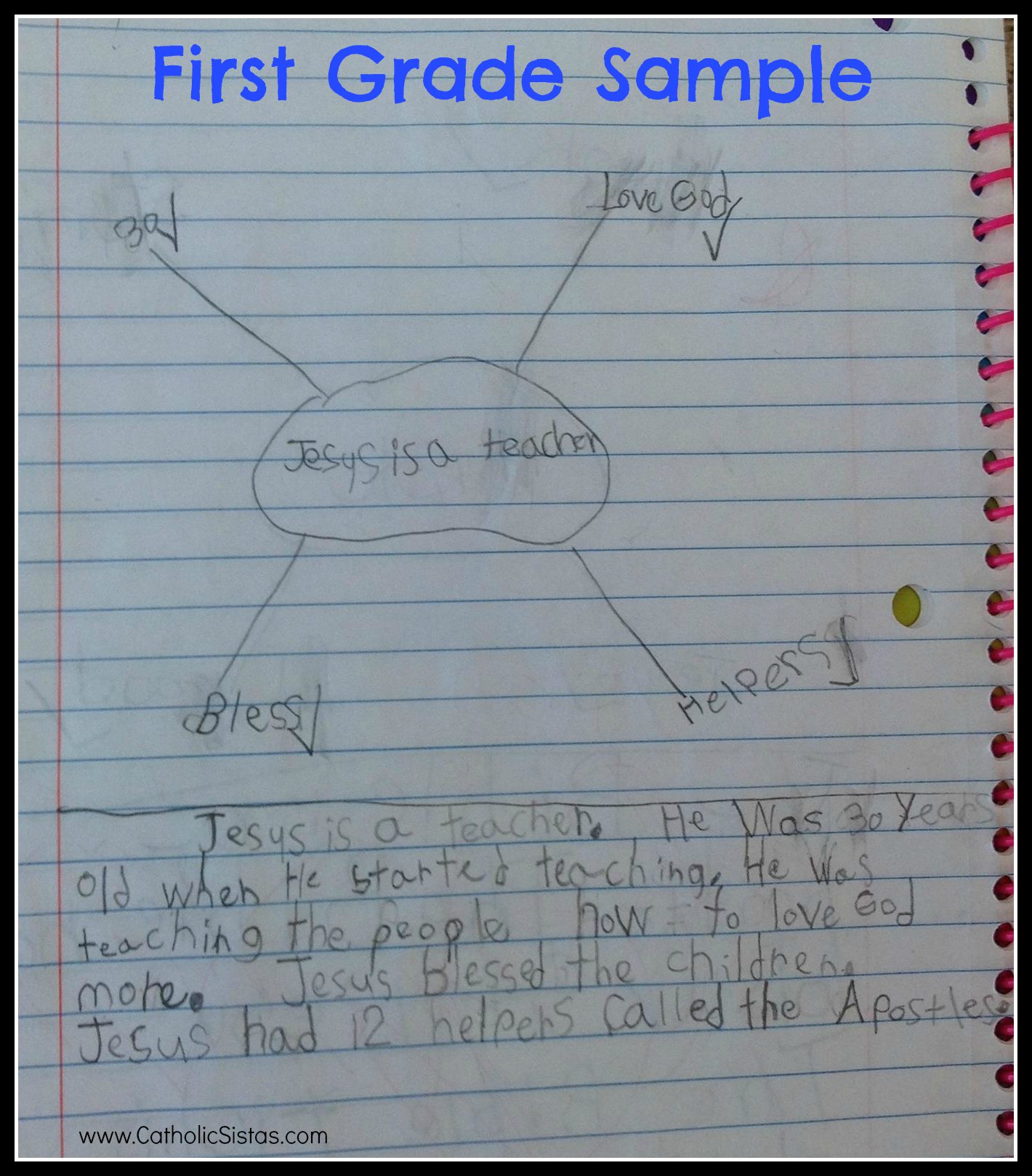
First Grade Writing Sample
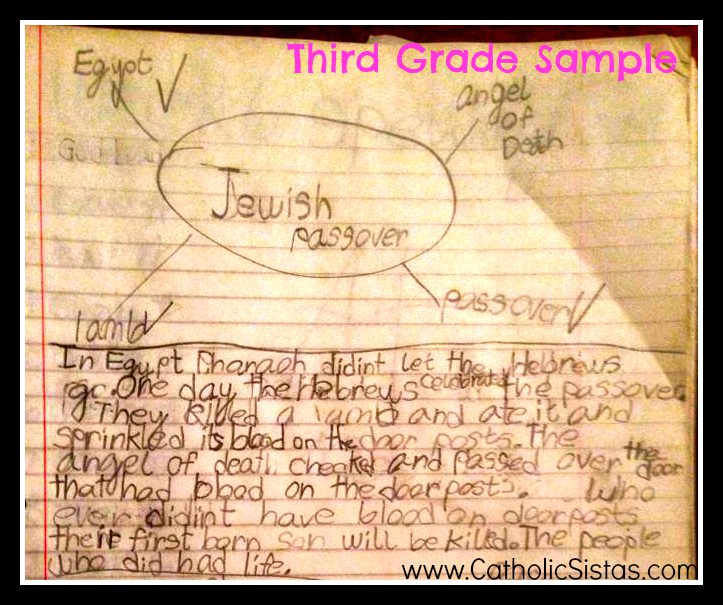
Third Grade Writing Sample
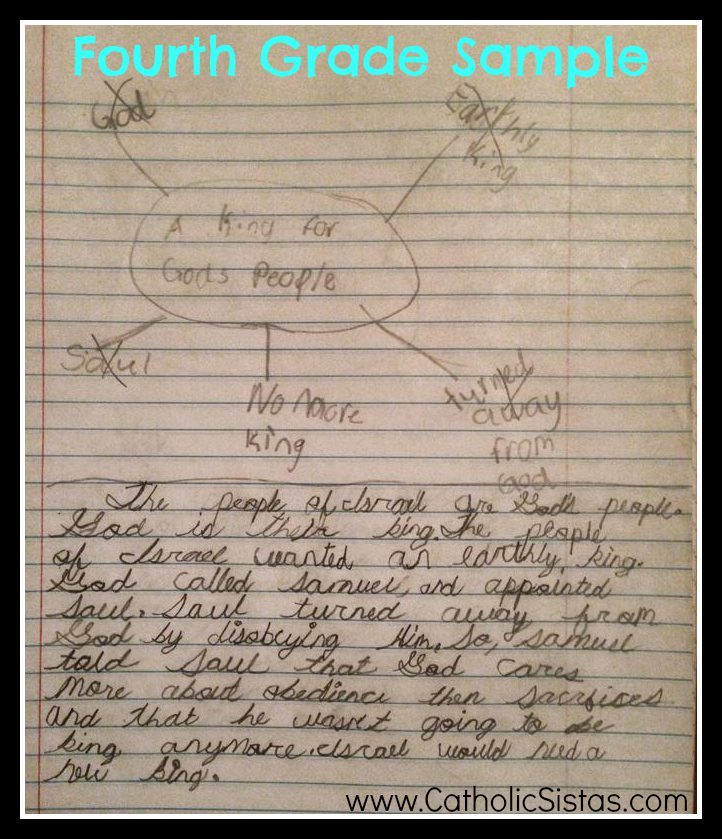
Fourth Grade Writing Sample
*** This article was submitted and written by Kristi V. for Catholic Sistas’ Raising Little Saints Homeschooling Series ***
